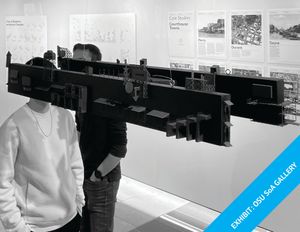Understanding the Towns of Oklahoma
Through the Lens of Architecture
The “Legend of the Town Centre: Ordinary Form Radical Ideology” explores, analyzes, critiques, and creates speculative models from the towns in Oklahoma by way of the history of town centers—a ubiquitous architectural typology that spans the history of the city. This examination utilizes architecture as a disciplinary lens for viewing a special moment in the history of America’s Expansion: the formation of towns just before, during, and after Oklahoma became a state.
As such, history is utilized as a conceptual genealogy, architectural discourse as a theoretical guide, and typology as a source of form and for inventive design methodologies.
The exhibition looks at four town typologies that materialized sometime between the 1850’s and 1910’s. It examines case studies from these typologies as a way to understand the role architectural form played in manifesting the ideologies of the communities that developed the state. In addition, the exhibition used architectural discourse to decipher how these towns make new contributions to the history of architecture and the city.
This exhibition comes from research that has been conducted through different academic collaborations with undergraduate students in the School of Architecture. The course ARCH 4100: The Legend of the Town Center initiated this architectural inquiry. Honors Credit students and a Wentz Scholar have also made contributions, creating a discursive conceptual dialogue that explores complex ways that architectural discourse can be both enhanced by case studies from Oklahoma but also used as ways of understanding these architectural and urban forms.
The exhibition is organized by two methods of research and representation:
- Case studies of town typologies
- Speculative and conceptual representations that provide images and models of these towns, depicting them in ways that we can never fully see in archival historical artifacts.
There are very few photos of these towns, and we never get a wholistic view of them through a single archival source. These depictions create artifacts that transport us to these towns. For example, detailed plans and architectural models are used to fill in these representational gaps, allowing us to visit these towns through architectural modes that represent the towns at the height of their development. These drawings and models act more like historical fictions than history books. These drawings are based on fact but also use architectural discourse and design methodologies to create speculative and conceptual images of these towns.
Towns in Oklahoma were constructed with “Ordinary Architectural Parts,” or seemingly banal elements of architecture that were used to create main streets. This fascinating use of architectural form that is first unassuming but then radical, cultural, and interactive reorients our perception of the history of the main street. This analysis discovers and highlights alternative historical narratives embedded in the construction of Oklahoma towns, exposing how they constributed to America’s westward expansion, but also highlights the histories of underrepresented communities. These speculative realities provide new implications for how architecture functions as a medium and messaging device in contemporary culture.

